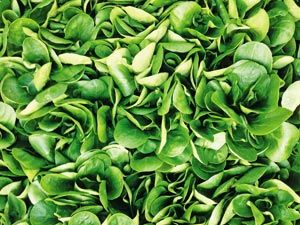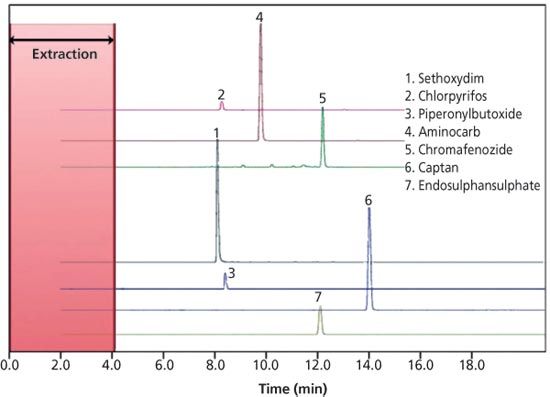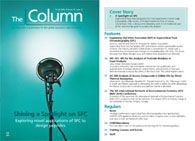SFE–SFC–MS for the Analysis of Pesticide Residues in Food Products
SFE–SFC–MS for the Analysis of Pesticide Residues in Food Products
Consumers are accustomed to all year round availability of a variety of reasonably priced fruit and vegetables in supermarkets, regardless of the season, which can only be achieved by using millions of tonnes of agricultural chemicals. Mineral fertilizers and pesticides are freely dispersed on fields and plantations, and their residues or degradation products can remain in our fruits, vegetables, and cereals. To protect consumers, fast and reliable methods for the qualification and quantification of residual chemicals, contaminants, and pesticides in food and feed are essential to ensure the safety of the food chain.
Photo Credit: Byron Hirsch/EyeEm/Getty Images

Pesticides are used in agriculture to protect plants and crops from detrimental influences.1 There are a number of different types of pesticide classified as herbicides, insecticides, bactericides, insect repellents, animal repellents, or fungicides that are all known to be harmful and of toxicological significance. Several testing methods are available that enable the detection and monitoring of residual chemicals in food. The conventional method for sample extraction of pesticideâcontaining matrices is QuEChERS sample preparation (quick, easy, cheap, effective, rugged, and safe). QuEChERS requires a number of steps before the final extract can be analyzed by a chromatographic technique as shown in Figure 1.2
Figure 1: QuEChERS sample preparation.

A new and efficient extraction process uses “supercritical” CO
2
for extraction as well as the chromatographic separation, which can shorten analytical run times, reduce solvent consumption, and reduce the risk of losses or error of measurement during sample preparation. Furthermore, extraction selectivity can be carefully controlled by adjusting the solvating power of the CO
2
through changes in pressure and temperature, making it faster, more efficient, and more versatile than liquid extractions.
3
Supercritical CO
2
is a fluid state of carbon dioxide where it is held at, or above, its critical temperature (31.1 °C) and critical pressure (73.8 bar). In this state, the physical and thermal properties are between a liquid and a gaseous phase and the fluid density is more sensitive to temperature and pressure changes.
4
The physicochemical properties of supercritical CO
2
near the critical point drastically change with only small variations in temperature or pressure making supercritical conditions a nonârobust area to work with in supercritical fluid chromatography (SFC).
5
In addition, solvent strength is often increased by using a polar co-solvent as CO
2
is non-polar at its critical point. As soon as an organic modifier is introduced, the mobile-phase is no longer truly supercritical, but the terminology is generally used regardless. These now “subcritical” conditions imply much lower changes in fluid density with a small variation in pressure or temperature and are therefore better suited for a robust, reproducible SFC separation (see Figure 2).
Figure 2: Phase diagram for (a) pure CO2 (critical point at 73.8 bar, 31.1 °C) and (b) 96.5% CO2/3.5% methanol (critical point at 83 bar, 40 °C).5

Case Study: SFE–SFC Analysis of a Spinach Sample
In an on-line SFE–SFC approach, solid food samples are homogenized with an absorbent powder, and placed in the extraction vessel in the SFE unit. Supercritical CO
2
is then introduced into the vessel, where extraction conditions can be adjusted. The sample is extracted under light-shielding, anaerobic conditions so that decomposition of even labile compounds can be avoided. After extraction in the SFE unit, the sample containing CO
2
is introduced in the SFC flowline for chromatographic analysis by SFC. The following study outlines the SFE–SFC analysis of spinach spiked with a concentration of 100 ppb of seven pesticides (sethoxydim, chlorpyrifos, piperonylbutoxide, aminocarb, chromafenozide, captan, and endosulphansulphate).
Method:
A sample of 1 g of spinach was homogenized, mixed with 1 g of absorbent, and entered into the extraction vessel. CO
2
was introduced into the vessel and the sample was extracted at 100 bar and 40 °C for 2 min using static extraction, then another 2 min using dynamic extraction before introduction of the extract into the SFC flow-line for analysis. SFC analysis for pesticide residues was performed on a 250 × 4.6 mm, 5-µm Inertsil ODS-EP HP column (GL Sciences) with a flow rate of 3 mL/min using CO
2
and 16 mM ammonium formate in methanol as an organic modifier in a gradient run: 0 to 11% modifier (4–15 min), 11 to 30% (15–18 min) and 30 to 40% (18–21 min) at 40 °C and at a pressure of 100 bar. An LCMSâ8050 triple quadrupole mass spectrometer (Shimadzu) was used in MRM mode.
Results
Figure 3 shows the SFC–MS chromatogram of 100 ppb pesticide residue extracted from a spiked spinach sample. Using this on-line SFE approach pesticides could be extracted, separated, and quantified in less than 20 min; using the QuEChERS method sample preparation alone takes approximately half an hour.
Figure 3: SFC–MS chromatogram of 100 ppb pesticide residue extracted from spiked spinach sample.

Conclusion
The on-line SFE–SFC–MS approach was used successfully to extract and analyze seven commonly used pesticides from a spiked spinach sample, in just a fraction of the time that the QuEChERS sample preparation method would take. This method offers an ideal alternative for laboratories wanting to improve effectiveness while reducing the risk of losses or error of measurement. There are also many other possible applications of SFE and SFC, such as recovery of organics from oil shale, separations of biological fluids, investigation of biomarkers, selective extraction of fragrances, oils, and impurities from agricultural and food products, pollution control, additives in polymers, drug discovery in pharmaceuticals and biopharmaceuticals, environmental controls, and cleaning validation.
6
References
1. http://ec.europa.eu/food/plant/protection/pesticides/index_en.htm
2. M. Anastassiades, S.J. Lehotay, D. Stajnbaher, and F.J. Schenck, J. AOAC Int.86(2), 412–431 (2003).
3. T. Letzel and S. Bieber, Analytik News8 (2015).
4. L.T. Taylor, Anal. Chem. 82(12), 4925–4935 (2010).
5. Eric Lesellier, ICOA, UMR 7311, SFC 2014
6. E. Reverchon and I. De Marco, Journal of Supercritical Fluids38(2), 146–166 (2006).
Gesa Schad
graduated with a diploma in chemical engineering from the Technical University, NTA in Isny, Germany, in 2004 and a Master of Science in pharmaceutical analysis from the University of Strathclyde in Glasgow, UK, in 2005. Until 2006, she worked as a consultant in HPLC method development and validation in an analytical laboratory of the FAO/IAEA in Vienna, Austria. She gained her doctorate for research in pharmaceutical sciences at the University of Strathclyde in 2010 and was employed as HPLC specialist in the R&D department at Hichrom Ltd. in Reading, UK, from 2009. Since 2013, she has worked in the analytical business unit of Shimadzu Europa in Duisburg, Germany, as a HPLC product specialist. E-mail:
shimadzu@shimadzu.eu
Website:
www.shimadzu.eu

New Study Reviews Chromatography Methods for Flavonoid Analysis
April 21st 2025Flavonoids are widely used metabolites that carry out various functions in different industries, such as food and cosmetics. Detecting, separating, and quantifying them in fruit species can be a complicated process.
Analytical Challenges in Measuring Migration from Food Contact Materials
November 2nd 2015Food contact materials contain low molecular weight additives and processing aids which can migrate into foods leading to trace levels of contamination. Food safety is ensured through regulations, comprising compositional controls and migration limits, which present a significant analytical challenge to the food industry to ensure compliance and demonstrate due diligence. Of the various analytical approaches, LC-MS/MS has proved to be an essential tool in monitoring migration of target compounds into foods, and more sophisticated approaches such as LC-high resolution MS (Orbitrap) are being increasingly used for untargeted analysis to monitor non-intentionally added substances. This podcast will provide an overview to this area, illustrated with various applications showing current approaches being employed.

.png&w=3840&q=75)

.png&w=3840&q=75)



.png&w=3840&q=75)



.png&w=3840&q=75)






